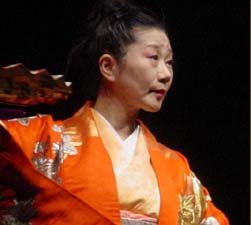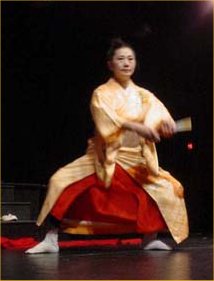Kabuki
Artist Comes to Mason
GM’s IB Theater Arts Class
Starts
Its New Unit With Shuzumi
By Nora Hemphill
(March 4, 2005)
This past Friday
the IB Theater Arts class kicked off its
new unit with an unusual yet stunning performance by Shuzumi, a
Japanese dancer.
The Theater Arts instructor, Ms. Ricker,
eagerly shared Shuzumi’s talents with any students who attended. Those
in
theaudience were treated to a mesmerizing performance and a glimpse
into an
ancient form of dance called kabuki.
 Kabuki is one of the
earliest forms of Japanese dance, its
roots dating back over 600 years. The dances are composed of a series
of highly
stylized movements that tell the story of almost anything—from
relationships
between loved ones to a man eating a noodle. Although the dancer does
speak
sometimes, his or her words are spoken in a Japanese tongue so old that
even
the Japanese cannot understand it. Because of this, the stories are
told
through the dancer’s facial expressions, movements, costumes, and use
of fans.
Kabuki is one of the
earliest forms of Japanese dance, its
roots dating back over 600 years. The dances are composed of a series
of highly
stylized movements that tell the story of almost anything—from
relationships
between loved ones to a man eating a noodle. Although the dancer does
speak
sometimes, his or her words are spoken in a Japanese tongue so old that
even
the Japanese cannot understand it. Because of this, the stories are
told
through the dancer’s facial expressions, movements, costumes, and use
of fans.
Shuzumi wore several different kimonos
throughout her
performance, changing from a traditional woman’s dress to that of a
man’s
several times. She used masks to portray various characters, and a fan
to
convey different actions. Instead of having many assorted props, kabuki
artists
use mainly fans. The type of fan used varies based on the mood of the
dance,
but no matter what the fan looks like, it is often the focus of the
dance, the
artist transforming it from a book to chopsticks or using it to convey
the type
of character currently being portrayed.
 The entire
middle section of the auditorium sat transfixed
as Shuzumi’s face changed from expression to expression, her motions
shifting
between the shy, more fluid movements of a Japanese lady to the stiffer
and
harsher movements of the Japanese husband. As the music ended, Shuzumi
stopped
and proceeded to tell the students about herself and her training. When
she was
14 years old, Shuzumi went to a kabuki master in her town and asked him
to
teach her kabuki (kabuki is not taught widely as is Western dance, but
is
instead passed down from generation to generation). The master looked
at her,
perplexed. An old Japanese custom restricts women from performing
kabuki in
that country and he did not understand why Shuzumi wished to be trained
in
something she could not perform. She explained to him that she was
going to
America someday and could dance kabuki there. After much persistence on
Shuzumi’s part, the kabuki master agreed and began to train Shuzumi in
the art
of kabuki and the dance of her ancestors. A few years later, Shuzumi
was
invited to join the San Francisco ballet and her dream of moving to
America
came true.
The entire
middle section of the auditorium sat transfixed
as Shuzumi’s face changed from expression to expression, her motions
shifting
between the shy, more fluid movements of a Japanese lady to the stiffer
and
harsher movements of the Japanese husband. As the music ended, Shuzumi
stopped
and proceeded to tell the students about herself and her training. When
she was
14 years old, Shuzumi went to a kabuki master in her town and asked him
to
teach her kabuki (kabuki is not taught widely as is Western dance, but
is
instead passed down from generation to generation). The master looked
at her,
perplexed. An old Japanese custom restricts women from performing
kabuki in
that country and he did not understand why Shuzumi wished to be trained
in
something she could not perform. She explained to him that she was
going to
America someday and could dance kabuki there. After much persistence on
Shuzumi’s part, the kabuki master agreed and began to train Shuzumi in
the art
of kabuki and the dance of her ancestors. A few years later, Shuzumi
was
invited to join the San Francisco ballet and her dream of moving to
America
came true.
Shuzumi performed Western dance for 20
years, but is now
returning to her roots. She works with Class Act, a performance group
in
Maryland, and she also teaches kabuki to those interested in the
Japanese
dance. For the next two weeks, Shuzumi will be teaching the IB Theater
Arts
class how to dance kabuki. One can only hope that as more people became
aware of
the dance, the 600-year-old art will have a greater chance of being
preserved
for another 600 years.

